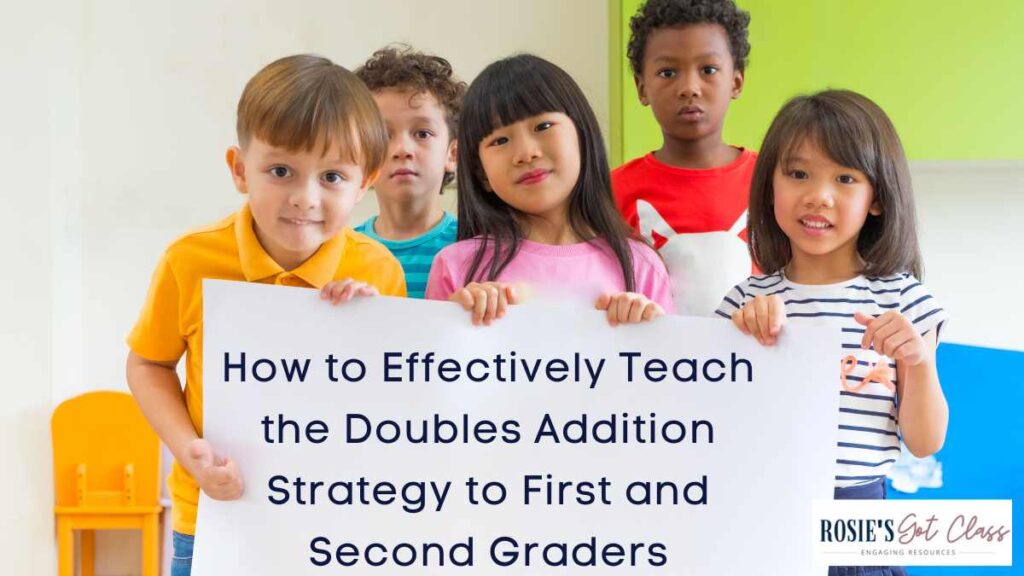
Teaching the doubles addition strategy is an important part of early math lessons because it helps students develop number sense. One of the most effective strategies to introduce to first and second graders is the doubles strategy. Not only does it help students quickly solve addition problems, but it also builds a strong foundation for understanding more complex math concepts. Let’s discuss what the doubles strategy is, how to teach it, and why practice is key to mastering it.
Before we discuss this addition strategy, let’s look at a fun way to practice and apply using these math skills. After your students have learned their mental math strategies, you will be moving onto teaching two-digit addition. One reason we learn these strategies is to help us when we move onto two-digit and three-digit addition. Knowing how to solve smaller equations helps students so they don’t get lost in the process of solving bigger problems. This Build a Robot activity is just the ticket to help your students practice their math skills. Put your name and email address in the boxes, and I will send it right to your inbox.
What is the Doubles Addition Strategy?
The doubles strategy is a simple yet powerful addition technique. It involves doubling a number which means adding the same number to itself. For example, if you have 3, you double it to get 6 (3 + 3 = 6). One of the interesting things about the doubles strategy is that the sum is always an even number. This makes it easy for students to recognize patterns and apply the strategy to different situations.
Understanding doubles is more than just memorizing facts. It’s about recognizing patterns, visualizing quantities, and connecting math to the real world.
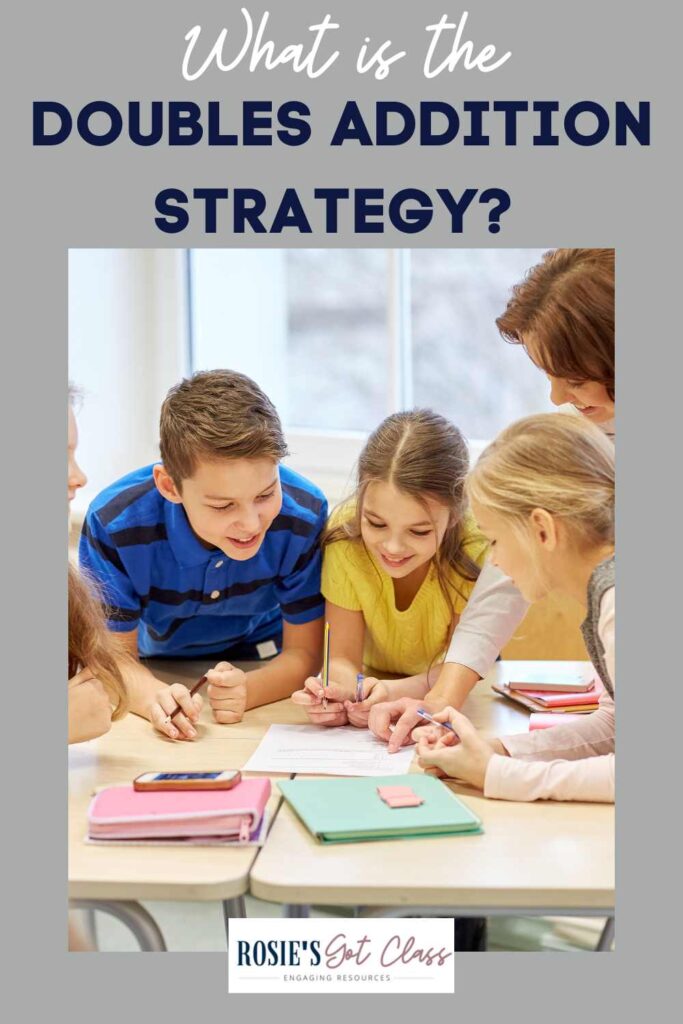
How to Teach the Doubles Addition Strategy
When teaching the doubles strategy to first and second graders, it’s essential to make the process hands-on and engaging. Let’s look at a few effective teaching methods that can help students grasp this concept.
One of the most exciting ways to introduce the doubles strategy is by using a mirror. They provide a concrete and visual representation of doubling which makes it easier for students to understand the concept.
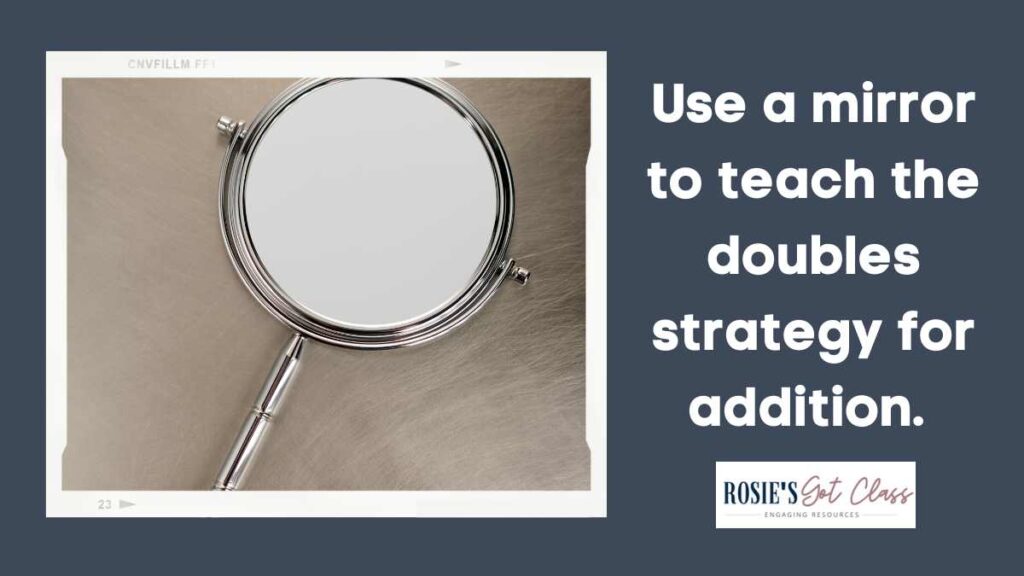
How to Do It:
Start by holding up a small object such as a toy or a block. Ask the students how many objects they see.
Then put the object in front of a mirror.
– Ask the students how many objects they see.
– Gradually add more objects in front of the mirror and ask the students to count the total number of objects including the reflection.
– Continue the activity by doubling the number of objects each time and reinforcing that doubling means adding the same number twice.
This method is a visual way to introduce the idea of doubling and helps students see the concept in action.
Ten Frames: Using Colors to Show Doubles
Ten frames are a powerful tool for teaching various math concepts, and they work well for teaching doubles. By using two different colors, students can see how a number is doubled and count the total.
How to Do It:
– Begin with an empty ten frame.
– Use one color to fill in the first number of the doubles fact. For example, if you’re teaching 4 + 4, fill in 4 spaces with one color. I like to put the first number on the top row.
– Then use a different color to fill in the same number of spaces on the bottom row to show the doubling.
– Have the students count the total number of spaces filled in the ten frames.
-When you begin doubling 6, then I do the same in two ten frames. I use the top ten frame for the first number and the bottom ten frame for the number being doubled.
This visual representation reinforces the concept that doubling a number means adding the same number twice.
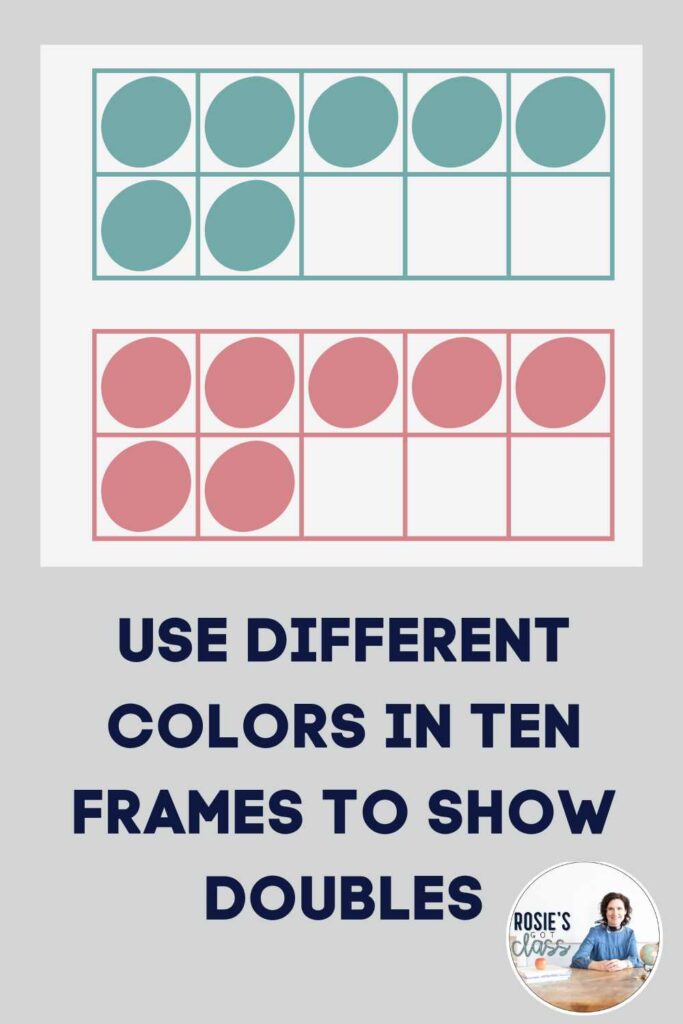
Real-Life Doubles: Connecting Math to the Real World
Making connections between math and the real world is crucial for young learners. By showing students how doubles exist in their everyday lives, you make math more relatable.
As a class, I like to have my students come up with their own examples of doubles they see in the world around them. This activity not only reinforces the concept but also makes it fun.
Here are a few examples to help you get started.
– Eyes: We have two eyes which is one doubled.
– Fingers and Toes: Two hands with ten fingers and two feet with ten toes.
– Spider Legs: A spider has eight legs which is a double of four.
– Soda Cans: A six-pack of soda has two rows of three which is a double of three.
– Dozen Eggs: A dozen eggs is made up of two groups of six.
– 7 Days in a Week: Two weeks make 14 days which is a double of seven.
– Octopus Legs: An octopus has eight legs which is a double of four. Sometimes it is tricky to come up with a double for 8 so you could use two octopuses.
– 18-Wheeler Truck: This truck has 18 wheels which is a double of nine.
Pinterest also has many examples that might help you further.
Use the CRA Model: Concrete, Representational, Abstract
To ensure a deep understanding of the doubles strategy, it’s important to follow the CRA model which stands for Concrete, Representational, and Abstract Thinking. This model helps students move from hands-on activities to more abstract thinking.
Concrete: Building with Ten Frames
Start with concrete examples by using ten frames. Provide students with counters or blocks to fill in the ten frames to represent different doubles facts.
Activity:
– Give each student a ten frame and some counters.
– Ask them to show a doubles fact, such as 5 + 5, by filling in five spaces with one color and then filling in the remaining five spaces with a different color.
– Have them count the total to reinforce the concept of doubling.
They will need a second ten frame and more counters when you double numbers larger than 5.
This hands-on activity helps students visualize and understand the doubles strategy in a concrete way.
Representational: Drawing with Ten Frames
Once students are comfortable with the concrete representation, then it is time to move to the representational stage. In this phase, students draw the ten frames instead of using physical objects.
Activity:
– Provide students with 1 or 2 blank ten frame templates.
– Ask them to draw counters or color in the spaces to show a doubles fact just like they did with the actual ten frames.
– Have them write the corresponding equation underneath the drawing (e.g., 6 + 6 = 12).
Drawing ten frames helps students make the transition from concrete to more abstract thinking while still providing a visual representation.
Abstract: Doubles Addition Equation
Finally, have your students move to the abstract stage where students work with numbers and symbols alone. At this point, they should be able to write and solve doubles equations without relying on visual aids.
Activity:
– Present students with a list of doubles facts and ask them to write the corresponding equations (e.g., 7 + 7 = 14).
– Challenge them to solve the equations on their own while reinforcing that doubling means adding the same number twice.
This abstract practice solidifies their understanding and prepares them for more advanced math concepts.
Practice Makes Perfect: Adding Doubles Activities
Teaching the doubles strategy is just the beginning. To ensure students master this technique, regular practice is essential. Here are some effective ways to reinforce the doubles strategy.
Math Centers with Games
Incorporate the doubles strategy into your math centers by using games that focus on doubling. For example, you could have students roll a dice, double the number, and write down the equation. If you want your students to also practice doubling numbers larger than 6, they will need two dice. They will roll both dice and add the numbers on the dice together to get the number they will double. You could also do this same game with a set of number cards. These hands-on activities make practice enjoyable and help solidify the concept.
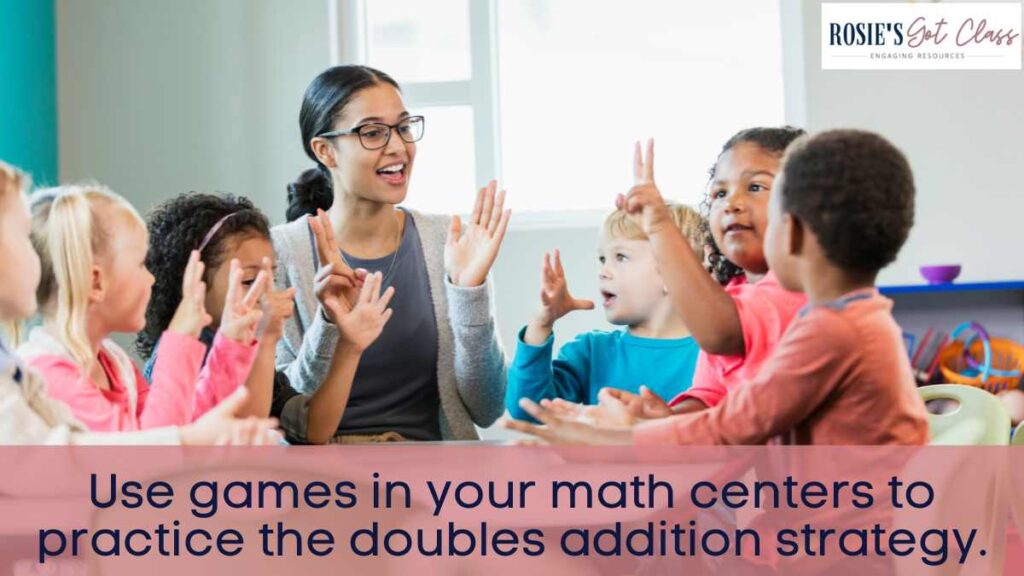
Morning Meeting Review
A review during your morning meeting is a great way to keep the doubles strategy fresh in students’ minds. You can ask a daily doubles question, have students solve a doubles equation on the board, or even sing a doubles song together. This daily reinforcement helps ensure that students retain what they’ve learned.
In conclusion, the doubles strategy is one of the essential strategies for addition that first and second graders need to master. By using engaging methods like mirrors, ten frames, real-life examples, and the CRA model, you can help your students understand and apply this strategy effectively. Remember, practice is key! With consistent practice and a variety of teaching methods, your students will soon be doubling numbers with ease which sets a strong foundation for future math success!
Here are some other articles you might find helpful.
How to Teach the Doubles Facts So Your Students Actually Understand


